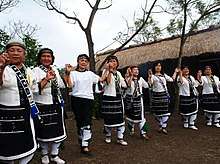Kavalan people
The Kavalan (endonym "kbaran" [kɨβarán]; "people living in the plain") (Chinese: 噶瑪蘭族) or Kuvalan are an indigenous people of Taiwan. The Kavalan originally inhabited the Kabalan Plain of modern-day Yilan County. Most of them moved to the coastal area of Hualien County and Taitung County in the 19th century due to encroachment by Han settlers. Their language is also known as Kavalan. Currently, the largest settlement of Kavalan is Xinshe (Kavalan: pateRongan) Village in Fengbin Township, Hualien County.
kbaran, kebalan | |
|---|---|
 | |
| Total population | |
| 1,460 (2018) | |
| Regions with significant populations | |
| Taiwan | |
| Languages | |
| Kavalan, Mandarin, Taiwanese Hokkien | |
| Religion | |
| Animism, Christianity | |
| Related ethnic groups | |
| Taiwanese Aborigines |
History
Legend has it that the Kavalan arrived by sea from the east and that when they saw the stunning beauty of this location, they decided then and there to settle this bountiful land. The newly arrived Kavalan fought many battles against the local Atayal people, and in the end the Kavalan drove the Atayal into the mountains — true to their name "Kavalan", which means "flatland people". That name subsequently morphed into "Hamalan", ultimately yielding the modern-day "Yilan City". They were referred as 36 Kavalan tribes (蛤仔難三十六社), although there were more than 60 tribes. In the past, tribes north of the Lanyang River were called Saisehoan (西勢番) while those south of the river were Tangsehoan (東勢番).
The earliest record of Kavalan in history was in 1632, when a Spanish ship went astray to this area by a typhoon. More clear record came in 1650 by Dutch East India Company (VOC). Reportedly, at some point there was a Spanish province of "Cabarán" in the area. Han Chinese tried to settle in the area as early as 1768. However, the settlement did not succeed until 1796, when Ngô͘ Soa (吳沙) established the first village (now Toucheng). Eventually, many more Han Chinese entered this area and the life of Kavalan was forced to change. Many of them moved to Beipu Village (in Sincheng Township of Hualien County) between 1830 and 1840.
Karewan Incident
In 1878, the Kavalan, and their Sakizaya allies, fought a devastating battle against Qing invaders.[1] This event ended in disaster for the both communities causing many of their members to be slaughtered in an event called the "Takobowan Incident"[2] (also known as the “Galeewan Incident”[3] or “Kalyawan Battle” zh:加禮宛事件).[4] Others were displaced by Han settlers.[3] The remaining Sakizaya, meanwhile, were forced to blend with other peoples, such as the Ami, with the intention of protecting their identity.[5]
See also
- Kavalan language
- Yilan County
- Taiwanese aborigine
- Hualien County
Further reading
References
- Faure, David (2001). "Mountain Tribes Before Japanese Occupation". In Faure, D. (ed.). In Search of the Hunters and Their Tribes. Taipei: Shung Ye Museum of Formosan Aborigines Publishing. pp. 19–21. ISBN 957-30287-0-0.CS1 maint: ref=harv (link)
- Sakizaya becomes the 13th indigenous group. Taiwan Journal. Published on January 26, 2007. Retrieved on May 5, 2007.
- Sakizaya Geographic Distribution. Taiwanese Council of Indigenous Peoples. Retrieved on February 28, 2008
- A comparative study of Sakizaya and Amis in Hualien by mitochondrial DNA sequences analysis (abstract) Archived 2011-05-29 at the Wayback Machine. Li-huang Tsai. Retrieved on March 2, 2008
- Taiwan recognises 'lost' people. BBC News. Retrieved on January 19, 2007